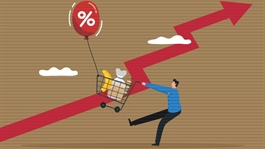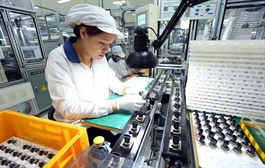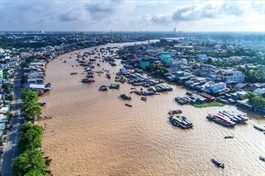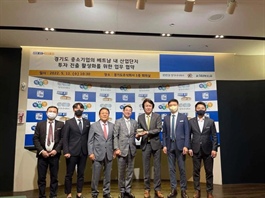Long-term action plans to service a circular economy
Long-term action plans to service a circular economy
Vietnam’s pursuit of a circular economy is offering numerous opportunities for businesses. However, in order for this new model to flourish, the government needs to create momentum.

Vietnam cooperates with the EU, Japan, and many other countries to establish a circular economy, Le Toan
As an emerging industrial hub with rapid economic growth, Vietnam has been facing environmental issues, particularly in waste management and plastic pollution. The total volume of waste in the nation is about 25.5 million tonnes annually, of which 75 per cent goes into landfills.
According to the World Bank, Vietnam annually generates about 280,000 tonnes of plastic waste. COVID-19 has exacerbated this situation due to increased usage and disposal of facemasks, sanitiser bottles, and e-commerce packaging.
With growing urbanisation and a growing middle class, the consumption and demand for plastics have also soared in consumer packaging, construction, household goods, and automotive industries.
In 2019, the plastic sector has contributed around $17.5 billion to Vietnam’s economy, tantamount to 6.7 per cent of the economy’s GDP. On average, a Vietnamese annually consumes 41.3kg of plastics, or 7,600 plastic grocery bags.
To address the situation and towards a sustainable economy, the government has been implementing long-term action plans, with ambitious recycling targets.
For instance, Vietnam has initiated a national action plan for the management of marine plastic litter, aiming to reduce 75 per cent of Vietnam’s marine plastic debris by 2030. By then, the nation will eliminate the use of single-use plastics and non-biodegradable plastic bags from all coastal tourism areas. Meanwhile, all protected marine areas should be free of plastic trash.
Last November, Prime Minister Pham Minh Chinh committed that Vietnam will make efforts to achieve net-zero emissions by 2050 with its own resources and international support. However, building a circular economy (CE) necessitates more than just facilitating recycling, reusing, and regenerating. Experts pointed out that it specifies a hierarchical transformation in distribution and consumption at both micro and macro levels.
Implications for businesses
The revised Law on Environmental Protection (LEP) introduces the concept of CE through fostering an extended producer responsibility (EPR) policy, highlighting the responsibility of producers and importers to recycle products and packaging.
The LEP requires that domestic solid waste must be sorted into reusable or recyclable solids, food waste, and other solid domestic waste. Additionally, producers and importers of products and/or packages with recycling value are responsible for collecting them for post-use recycling at the obligatory recycling rates. This applies to both recyclable products and packaging, and waste treatment.
According to pan-Asia consultancy firm Dezan Shira & Associates, there are two options to which manufacturers can comply with the law. Firstly, manufacturers can organise the recycling themselves according to the given rates and specifications. Secondly, they can contribute financially to the Vietnam Environment Protection Fund (VEPF) to support the recycling of their waste.
For example, laptops are products of recycling value. As such, they must be collected for recycling at the recycling rate of 20 per cent and according to stated specifications. For example, if Producer A sells three million kilogrammes worth of laptops on the Vietnamese market in one year under brand A, Producer A must collect and recycle 600,000kg of after-use or abandoned laptops.
The LEP’s Article 55 states, “Organisations and individuals producing and/or importing packages containing toxic substances, which are barely recyclable or impede collection and treatment, shall pay financial contributions to support daily-life solid waste treatment activities.”
For example, as per the regulations, cigarette producers and importers are required to pay VND100 (0.4 US cents) to the VEPF for every 20 cigarettes produced. This is because cigarette tubes are difficult to be collected and treated, requiring producers and importers to contribute to the VEPF.
Encouraging plastic recycling in businesses is expected to mobilise increased private sector investment to help address plastic pollution while supporting key industries such as tourism, shipping, and fisheries.
“To comply with the law, Vietnam’s manufacturers and producers will now have to register recycling plans and report recycling results annually to the Ministry of Natural Resources and Environment (MoNRE). Local and foreign-invested companies are also advised to prepare recycling plans and budgets for EPR accordingly to address new requirements imposed by the new law,” Dezan Shira & Associates said.
Driving forces
Effective driving forces are necessary to put CE into practice. In this sense, regulatory, technical, and financial measures are proposed in the National Action Plan on Circular Economy (NAPCE), which is now being drafted by the Japan International Cooperation Agency (JICA) and the MoNRE.
The NAPCE, drafted with CE experiences from Japan taken into account, aims to provide the basic directions, roadmap, identification of priority sectors, and implementation framework to realise CE in Vietnam towards the timeline of 2025-2035.
The strategic goals of the plan are establishing a sound material-cycle society, extending sound waste management and recycling, creating circular business models and markets, and ensuring sustainable financing for realising CE in all spheres of production and consumption.
The NAPCE highlights several measures. Specifically, regulatory measures shall include the application of EPR and the polluter-pay principle for businesses to realise CE in the process of manufacturing and delivery chain with the aim of implementing CE upstream. This can be followed by a legal measure to enhance the introduction and operation of reasonable waste collection and transportation and treatment to recover resources as much as possible and minimise final disposal.
Technical measures have much to do with CE realisation, such as the introduction of cost-energy-efficiency equipment to streamline the production and service delivery process and gathering data from customers and customers to develop more durable and long-lasting products.
Financial measures play a crucial role in securing and supporting CE implementation in which the government creates a financing scheme to support CE businesses, companies and entrepreneurs to develop circulative business ideas and models. The EU, Japan, and many other countries have established funding programmes to support the transition from a linear economy to CE by the introduction and investment funds, government subsidies, and the establishment of public-private partnership (PPP) schemes.
“In addition, boosting cooperation with regional and international stakeholders is one of the key driving forces to implement CE in Vietnam. Considering many business activities are running beyond country boundaries, CE should be carried out involving domestic and regional as well as international stakeholders,” said a JICA document on the NAPCE.
However, Nguyen Quang Vinh, chairman of the Vietnam Business Council for Sustainable Development said that in order for the CE in Vietnam to develop, the government needs to establish a market for secondary materials to be traded.
“Currently, there is no specific legal framework for such materials, and enterprises have to compete strongly and even unhealthily to purchase materials,” Vinh said. “If there is a framework, which is now available elsewhere, more enterprises will work with the government in developing a CE via PPPs,” Vinh said.
According to Andrew Mangan, co-founder and executive director of the US Business Council for Sustainable Development, a reuse and recycling materials trading system will help direct Vietnam’s booming manufacturing industries towards the CE. It is necessary to establish an active and vibrant Vietnam materials marketplace programme that serves as a foundation for well-informed, systematic industrial material reuse and recycling.



















